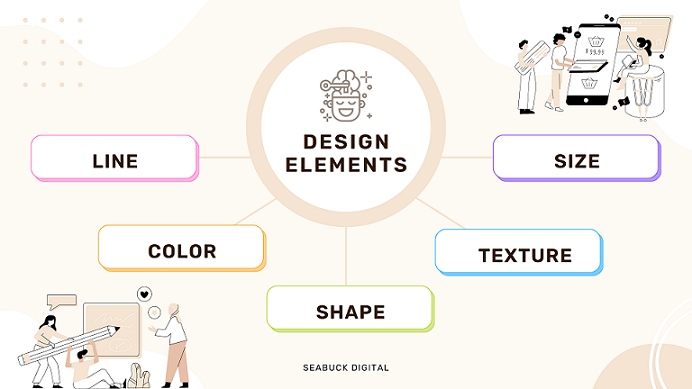I. Introduction
Visual marketing and design are critical components of modern business. We are all aware that we are in the digital age. Businesses must find creative and compelling ways to capture the attention of their target audience. That’s where visual marketing and design come in.

A. Explanation of visual marketing and design
Using eye-catching visuals like photos, films, and infographics to grab people’s attention and deliver a message about a product or service is the foundation of visual marketing and design. The goal is to provide content that is not only visually appealing but also engages readers. Content must convey information to readers that they will find interesting or valuable. Making something appealing is important, but so is creating something that encourages consumers to interact with your brand or product.
B. Importance of visual marketing and design in modern business
The importance of visual marketing and design in modern business cannot be overstated. Your company needs to figure out how to distinguish out from the competition in the face of the growing volume of online material. Your company can use visual components to attract customers and deliver your message more effectively.
Visual marketing and design can also help your business to build brand recognition and recall. By incorporating consistent visual elements into your marketing campaigns, your business can create a strong visual identity that is instantly recognizable to your audience.
In addition, visual marketing and design can help your business improve its online presence and search engine optimization (SEO). Your company may enhance user experience, raise engagement, draw more backlinks, and generate more social shares by including high-quality pictures on your website and social media profiles.
II. The Power of Visuals in Marketing

Since they can grab viewers’ attention and present information in a style that’s simple to understand and remember, visuals are an effective marketing tool. Let’s examine the significance and power of images in marketing in more detail.
A. Importance of visuals in capturing the attention
First of all, pictures are excellent at drawing attention. In today’s world, people are always bombarded with information throughout the day. In this scenario, it is important to have something that stands out of the ordinary and general. This can be accomplished by using visuals like pictures, movies, and infographics because they can swiftly and attractively convey a message.
B. Impact of visuals on brand recognition and recall
Secondly, visuals can have a big impact on brand recognition and recall. By using consistent visual elements across all of your marketing materials, you can create a strong visual identity that people will start to recognize and associate with your brand. This can help increase brand recall and make your brand more memorable to potential customers.
C. Examples of successful visual marketing campaigns
There are many examples of successful visual marketing campaigns that have used visuals to great effect. For instance, the “Share a Coke” campaign by Coca-Cola used personalized labels with people’s names on them to encourage social sharing and generate buzz. Another example is the “Dumb Ways to Die” campaign by Metro Trains in Australia, which used a catchy song and cute visuals to convey an important safety message.
Overall, visuals are a key component of successful marketing campaigns. They help capture attention, build brand recognition and recall, and can make your message more memorable and engaging to your audience. Therefore, remember to include images in your next marketing effort in a way that is appealing and efficient.
III. Designing for Your Audience

Understanding your target audience on a deep level is essential when creating for them. Let’s examine why this is crucial and how you may produce designs that appeal to your target market.
A. Understanding your target audience
First and foremost try to understand and know your target audience. This is crucial as it will help you to create designs that will appeal to them. If you know their age, interests, and preferences then you will be able to tailor your designs to their specific needs and wants. For example, to make your designs more appealing to a younger audience you may use vibrant colors and trendy fonts.
B. Creating designs that resonate with your audience
Second, it’s critical to develop designs that connect with your audience since they foster a relationship between your company and your clients. People are more inclined to engage with your company and grow to be devoted customers when they see designs that speak to them and their interests.
C. Examples of effective designs for different audiences
There are many instances of successful designs for various audiences. For instance, to convey sophistication and elegance to an elderly demographic, you can choose muted colors and traditional fonts. On the other hand, if you want to appeal to a younger crowd then you may employ vibrant, lively graphics that appeal to their sense of adventure and pleasure.
In conclusion, identifying your target audience and producing designs that appeal to them are the key components of designing for your audience. By doing this, you may establish a relationship with your clients and produce designs that are especially relevant to them. Hence, spend some time learning about your audience and then adjust your designs to suit their unique requirements and preferences.
IV. Design Elements and Principles

Design elements and principles are the building blocks of effective visual marketing. Let’s take a closer look at what they are and why they’re so important.
A. Overview of design elements and principles
The elements of design are the basic components of a visual design. The basic elements are color, shape, line, and texture. On the other hand, design principles are the guidelines that designers use to arrange those elements in a way that’s visually appealing and effective.
B. Importance of using design elements and principles in visual marketing
Using design concepts and aspects is crucial because they enable you to produce designs that successfully convey your message while also being aesthetically beautiful. You can make designs that arouse the emotions and sentiments you want your audience to feel by carefully choosing the colors, forms, and other design components you use.
C. Examples of effective use of design elements and principles in visual marketing
There are many examples of effective use of design elements and principles in visual marketing. For instance, using a limited color palette can create a sense of consistency and unity in your designs. Choosing the right font can also help convey the tone and personality of your brand.
Another example is the use of negative space or the space between design elements. Using negative space effectively can create a sense of balance and harmony in your designs, and make your message stand out more.
In summary, design elements and principles are key to creating effective visual marketing. By properly utilizing them, you can produce designs that not only look fantastic but also effectively convey your message to your target audience.
Hence, to create designs that are both aesthetically pleasing and functional, keep these aspects and concepts in mind while developing your next visual marketing campaign.
V. Visual Branding

Visual branding is about creating a visual identity that represents your brand. It helps the brand to be distinct in a crowded marketplace. Let’s examine why visual branding is crucial in more detail, as well as how to develop a visual brand style manual that will help you maintain consistency in all of your marketing collateral.
A. Importance of visual branding in establishing brand identity
Firstly, visual branding is crucial in establishing your brand identity. By using consistent visual elements across all of your marketing materials, you can help your audience recognize your brand more easily and establish a sense of trust and credibility. No matter where your consumer sees your brand, they should be able to recognize it right away.
B. Creating a visual brand style guide
You need to develop a visual brand style guide to accomplish this. This guide should outline the key visual elements that make up your brand. The guide should have an outline of your logo, color palette, typography, and imagery. You can make sure that all of your marketing materials are cohesive and on-brand by defining explicit rules for how these components should be used.
C. Examples of the successful visual branding
Examples of successful visual branding can be seen all around us. Just think about brands like Coca-Cola, Nike, or Apple. These companies have created visual identities that are instantly recognizable and communicate their brand values and personality effectively.
In summary, visual branding is essential in establishing your brand identity and creating a sense of consistency and credibility across all of your marketing materials. You can make sure that all of your designs are consistent and on-brand, making it simpler for your audience to recognize and relate to your brand by developing a visual brand style guide.
So, to generate a strong and consistent visual identity for your brand, keep visual branding top of mind while planning your next visual marketing campaign.
VI. Visual Marketing Tools and Platforms

You may produce and distribute visual content that connects with your target audience using visual marketing tools and platforms. But how can you pick the best options for your company out of the numerous that are available? Let’s examine the many visual marketing tools and platforms, how to pick the best ones, and some well-known examples.
A. Overview of visual marketing tools and platforms
Everything that enables you to generate and share visual material, such as social networking platforms, graphic design software, video editing tools, and more, is considered a visual marketing tool or platform. You can produce spectacular visuals that captivate viewers and clearly convey your message with the aid of these tools and platforms.
B. Choosing the right tools and platforms for your business
It’s critical to take your goals and target market into account while selecting the best tools and platforms for your organization. For instance, employing Instagram for your visual marketing efforts may be a wise move if your target demographic is active there. Alternatively, graphic design tools like Canva or Adobe Illustrator may be more appropriate if you’re wanting to produce infographics or other visual content.
C. Examples of popular visual marketing tools and platforms
Social media sites like Instagram, Pinterest, and TikTok are examples of well-known visual marketing tools and platforms that let you share images and videos with your audience. Canva and Adobe Creative Suite are popular graphic design software options, while video editing tools like iMovie or Adobe Premiere Pro can help you create engaging video content.
In conclusion, visual marketing tools and platforms are essential in creating and distributing visual content that resonates with your target audience. You can make eye-catching visuals that grab attention and effectively convey your message by selecting the platforms and tools that are best for your business and your audience.
Spend some time investigating the many possibilities to determine which ones are most suitable for your company.
VII. Measuring the Success of Visual Marketing

Understanding how successful your efforts are at reaching your target audience and accomplishing your objectives requires measuring the success of your visual marketing campaigns. Let’s examine the importance of monitoring the effectiveness of visual marketing, the metrics to monitor, and some successful visual marketing initiatives in more detail.
A. Importance of measuring the success of visual marketing
You may determine what is and is not working with your visual marketing initiatives by tracking their progress. You can study more about how your audience is interacting with your visual content. You can learn your audience’s behavior by monitoring metrics like engagement rates, click-through rates, and conversion rates. As a consequence, you’ll be more equipped to decide what to do next to strengthen your efforts and get greater outcomes.
B. Metrics to track for visual marketing campaigns
For visual marketing initiatives, there are many metrics to monitor. You can monitor the number of likes, shares, comments, and followers on social networking sites. Also, you may monitor website traffic and conversions brought on by your graphic content. You may learn more about how your images are influencing your audience’s behavior. The audience behavior can be studied by monitoring the time spent on your website, bounce rates, and click-through rates.
C. Examples of successful visual marketing campaigns and their metrics
Successful visual marketing campaigns often have high engagement rates, which means that people are interacting with and sharing your content. For instance, Coca-“Share Cola’s a Coke” campaign urged consumers to discover bottles with their names and post pictures on social media with the hashtag #ShareACoke.
More than 500,000 images were posted on social media as a result of this campaign, and sales rose by 2.5%.
To sum up, tracking the results of your visual marketing initiatives is essential to figuring out how successful your efforts are at reaching your target audience and realizing your objectives.
You can acquire insights that will help you enhance your campaigns and get better results by monitoring the appropriate metrics and reviewing your performance. So, take the time to track your metrics and learn from your successes and failures to create even more successful visual marketing campaigns in the future.
VIII. Impact of Visual marketing and Design on SEO

Visual marketing and design can have a significant impact on search engine optimization. SEO refers to the process of optimizing your website to rank higher in search engine results pages (SERPs) for specific keywords or phrases. Here’s how visual marketing and design can help with SEO:
1. Improved User Experience (UX):
On your website, visual components like pictures, videos, and infographics can improve the user experience. This can lead to increased time on site, lower bounce rates, and higher engagement rates, which are all positive signals for search engines. Google prioritizes user experience when determining search rankings, so a well-designed website with high-quality visuals can help improve your SEO.
2. Better Click-Through Rates (CTR):
Visual elements can also help improve your click-through rates (CTR) in search engine results pages (SERPs). Google often displays images and videos in search results, which can make your listings stand out and attract more clicks. Additionally, incorporating visual elements into your Meta descriptions can make them more compelling and increase the likelihood that users will click through to your website.
3. Social Sharing and Backlinks:
Visual content is more likely to be shared than plain text on social media platforms. This property of social media can help increase the visibility of your brand and attract more backlinks to your website. Backlinks from high-quality, authoritative websites are a key factor in search engine rankings, so having a strong visual marketing and design strategy can indirectly impact your SEO through increased social sharing and backlinking.
4. Optimized Images and Videos:
Finally, optimizing your visual content for search engines can also help improve your SEO. This includes using descriptive file names, adding alt text, and compressing image and video files to improve page load times. These optimizations can help search engines understand what your visual content is about and make it easier for them to crawl and index your website.
In summary, visual marketing and design can have a positive impact on your SEO through improved user experience, better click-through rates, increased social sharing and backlinking, and optimized visual content. You may increase the visibility of your website and draw more search engine traffic by including visual components in your SEO plan.
IX. Conclusion
A. Recap of the importance of visual marketing and design and its impact on SEO
Considering how much we’ve discussed visual marketing and design, I hope you can see how important it is to contemporary companies. But why is it so important? Well, visuals are great at capturing attention, and they have a huge impact on brand recognition and recall. Also, by producing designs that appeal to your audience, they might assist you in developing a deeper connection with them.
B. Final thoughts and recommendations.
In the end, you must understand that it’s not just about throwing together some pretty pictures. You need to know your target audience and create designs that appeal to them. Whenever you are creating a design targeting your audience, the design elements and principles come in. Design elements are the building blocks of visual design. They’re essential if you want to create effective visual content.
The time to start promoting your brand starts just after you have established your visual brand identity. There are numerous platforms and technologies available to assist you in doing this. Selecting the ones that are best for your company is crucial, though. The success of your visual marketing initiatives must also be evaluated so that you may adjust your approach and keep becoming better.
In conclusion, visual marketing and design are incredibly important for modern businesses, and they can have a big impact on your SEO efforts too. Therefore be sure to focus on your aesthetics and make an effort to develop fantastic designs that connect with your audience.
Read More:
A Definitive Guide to Digital Marketing in 2023 – SeabuckDigital
Key SEO Metrics to Track: The Complete Guide – Seabuck Digital
Google My Business Optimization Checklist: A Definitive Guide in 2023 – Seabuck Digital
ECommerce SEO Audit: A Comprehensive Guide – Seabuck Digital

